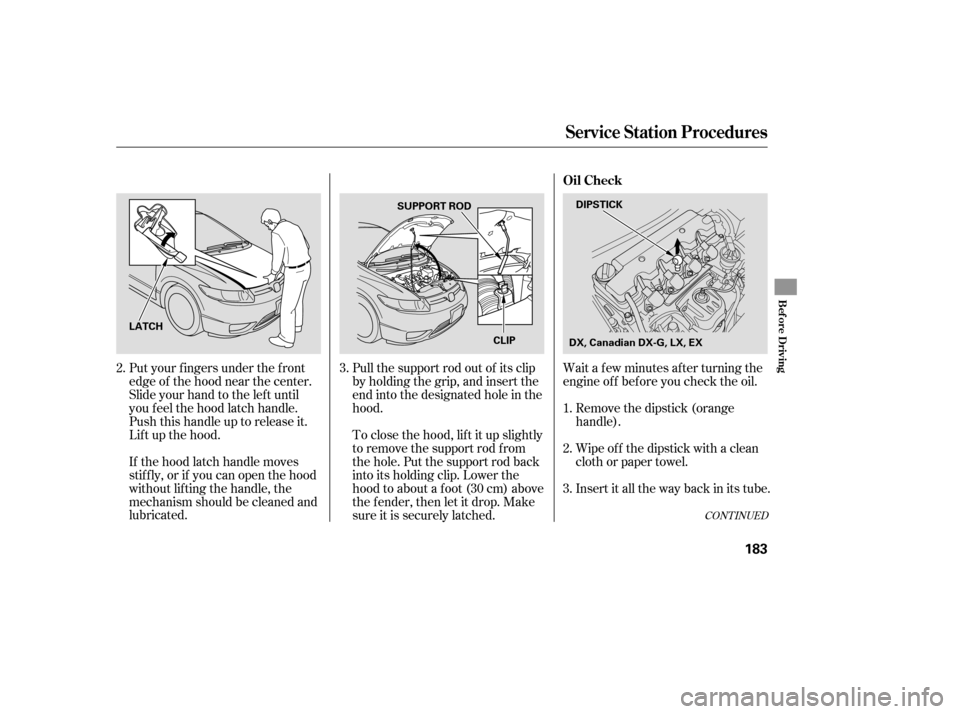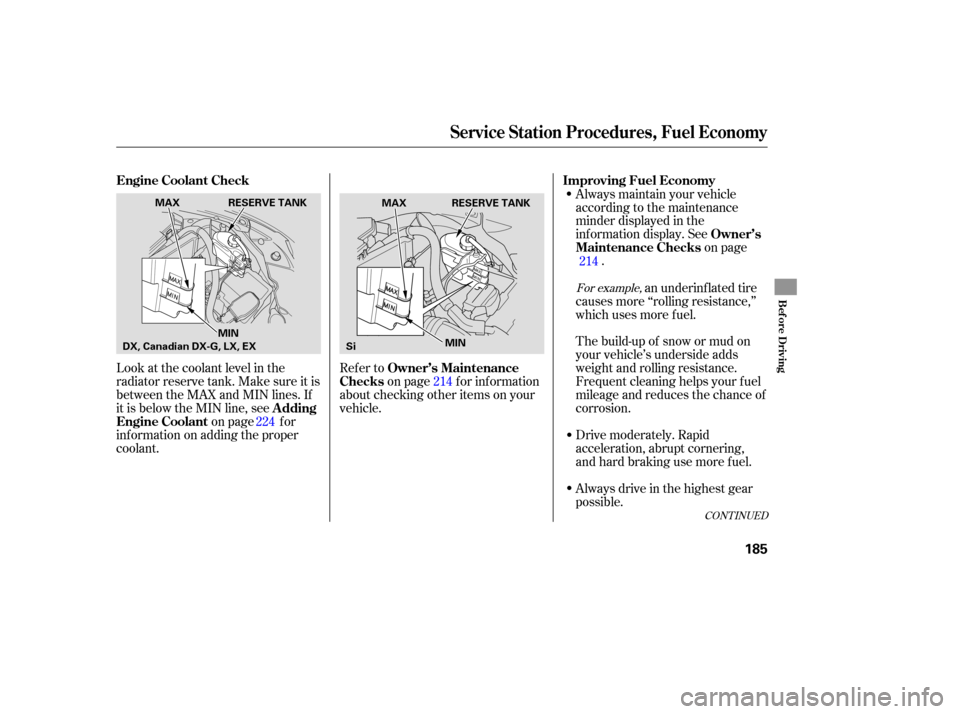Page 116 of 307

Air f lows f rom the f loor
vents.
When you select , the system
automatically switches to f resh air
mode. If you switch the mode f rom or to , the system
keeps the A/C on. The A/C
indicator will not come on if it was
off to start with.
To turn of f the A/C, press the A/C
button to illuminate the indicator,
then press it again to turn off the
A/C.
When you switch to another mode
from , the A/C turns off. But if
it was on to start with, the A/C stays
on.
Airf low is divided between
the f loor vents and the def roster
vents at the base of the windshield. Air f lows f rom the def roster
vents at the base of the windshield.
When you select or ,
the system automatically switches to
f resh air mode and turns on the A/C.
You cannot turn the A/C of f in this
mode.
The f low-through ventilation system
draws in outside air, circulates it
through the interior, then exhausts it
through vents near the rear window.
Set the temperature to the lower
limit.
Make sure the A/C is of f .
Select and fresh air mode.
Set the f an to the desired speed. The heater uses engine coolant to
warm the air. If the engine is cold, it
will be several minutes bef ore you
f eel warm air coming f rom the
system.
Select .
When you select , the system
automatically switches to f resh air
mode. If you switch the mode
f rom or , the system
also automatically turns on the
A/C. This helps prevent the
windows f rom f ogging up
unintendedly. The A/C indicator
willnotcomeonifitwasoffto
start with (see the f irst column on
this page).
Set the f an to the desired speed.
Adjust the warmth of the air with
the temperature control dial.
1.
2.
3.
4. 1.
2.
3.
Vents, Heating, and A/C
Ventilation
Using the Heater
112
�����—�����—�����y�
�����������
�y���
�(�+���������y���
�
���y
Page 117 of 307

Air conditioning places an extra load
on the engine. Watch the engine
coolant temperature gauge (see page). If it moves near the red zone,
turn of f the A/C until the gauge
reading returns to normal.
Turn on the A/C by pressing the
button. The indicator in the button
comesonwhenafanspeedis
selected.
Make sure the temperature is set
to maximum cool.
Select .
If the outside air is humid, select
recirculation mode. If the outside
air is dry, select f resh air mode.
Set the f an to the desired speed. you can
cool it down more rapidly by partially
opening the windows, turning on the
A/C, and setting the fan to
maximum speed in f resh air mode.
To cool the interior with MAX A/C: Set the f an to the desired speed.
Select MAX A/C mode.
The system automatically turns on
the A/C, selects , and
switches to recirculation mode.
Make sure the temperature is set
to maximum cool. Air conditioning, as it cools, removes
moisture from the air. When used in
combination with the heater, it
makes the interior warm and dry and
can prevent the windows f rom
f ogging up.
This setting is suitable f or all driving
conditions whenever the outside
temperature is above 32°F (0°C).
Turn the fan on.
Turn on the air conditioning.
Select and fresh air mode.
Adjust the temperature to your
pref erence.
1.
2.
3.
4.
5. 1.
2.
3.
4.
66
1.
2.
3.
If the interior is very warm,Dehumidif y the Interior
Using the A/C
Vents, Heating, and A/C
Features
113
�����—�����—�����y�
�������������y���
�(�+���������y���
�
���y
Page 183 of 307
Bef ore you begin driving your
vehicle, you should know what
gasoline to use and how to check the
levels of important f luids. You also
need to know how to properly store
luggage or packages. The
inf ormation in this section will help
you. If you plan to add any
accessories to your vehicle, please
read the information in this section
first..............................
Break-in Period .180
.................
Fuel Recommendation .180
.........
Service Station Procedures .181
....................................
Ref ueling .181
Opening and Closing
................................
the Hood .182
...................................
Oil Check .183
.............
Engine Coolant Check .185
...............................
Fuel Economy .185
...
Accessories and Modif ications .186
.............................
Carrying Cargo .188
Bef ore Driving
Bef ore Driving
179
�����—�����—�����y�
�������������y���
�(�+���������y���
�����y
Page 184 of 307

Help assure your vehicle’s f uture
reliability and perf ormance by paying
extra attention to how you drive
during the f irst 600 miles (1,000 km).
During this period:Avoid full-throttle starts and rapid
acceleration.
You should also f ollow these
recommendations with an
overhauled or exchanged engine, or
when the brakes are replaced. Avoidhardbrakingforthefirst
200 miles (300 km). Do not change the oil until the
scheduled maintenance time. We recommend using quality
gasolines containing detergent
additives that help prevent fuel
system and engine deposits.
In addition, in order to maintain good
perf ormance, f uel economy, and
emissions control, we strongly
recommend, in areas where it is
available, the use of gasoline that
does NOT contain manganese-based
f uel additives such as MMT.
Use of gasoline with these additives
may adversely af f ect perf ormance,
and cause the malfunction indicator
lamp on your instrument panel to
come on. If this happens, contact
your authorized dealer f or service.
Your vehicle is designed to operate
on unleaded gasoline with a pump
octane number of 87 or higher. Use
of a lower octane gasoline can cause
a persistent, heavy, metallic rapping
noise that can lead to engine damage.
Your vehicle is designed to operate
on premium unleaded gasoline with a
pump octane of 91 or higher. Use of
a lower octane gasoline can cause
occasional metallic knocking noises
in the engine and will result in
decreased engine perf ormance. Use
of a gasoline with a pump octane less
than 87 can lead to engine damage.
Break-in Period Fuel Recommendation
Break-in Period, Fuel Recommendation
A ll models except Si
Si model only
180
�����—�����—�����y�
�������������y���
�(�+���������y���
�����y
Page 185 of 307

CONT INUED
Park with the driver’s side closest
to the service station pump.
For f urther important f uel-related
inf ormation, please ref er to your
.
Some gasoline today is blended with
oxygenates such as ethanol or
MTBE. Your vehicle is designed to
operate on oxygenated gasoline
containing up to 10% ethanol by
volume and up to 15% MTBE by
volume. Do not use gasoline
containing methanol.
If you notice any undesirable
operating symptoms, try another
service station or switch to another
brand of gasoline.
You may hear a knocking noise from
the engine if you drive the vehicle at
low engine speed (below about 1,000
rpm) in a higher gear. To stop this,
raise the engine speed by shif ting to
a lower gear.
Open the f uel f ill door by pushing
onthehandletotheleftof the
driver’s seat.
1.
2.
On Si model
Service Station Procedures
Ref ueling
Quick Start Guide
Bef ore Driving
181
Push TETHERFUEL FILL CAPGasoline is highly flammable
and explosive. You can be
burned or seriously injured
when handling fuel.Stop the engine, and keep
heat, sparks, and flame away.
Handle fuel only outdoors.
Wipe up spills immediately.
�����—�����—�����y�
�������������y���
�(�+���������y���
�����y
Page 187 of 307

Wait a f ew minutes af ter turning the
engine of f bef ore you check the oil.
Put your f ingers under the f ront
edge of the hood near the center.
Slide your hand to the lef t until
you f eel the hood latch handle.
Push this handle up to release it.
Lif t up the hood.
If the hood latch handle moves
stif f ly, or if you can open the hood
without lifting the handle, the
mechanism should be cleaned and
lubricated. Pull the support rod out of its clip
by holding the grip, and insert the
end into the designated hole in the
hood.
To close the hood, lif t it up slightly
to remove the support rod f rom
the hole. Put the support rod back
into its holding clip. Lower the
hood to about a f oot (30 cm) above
the fender, then let it drop. Make
sure it is securely latched.
Remove the dipstick (orange
handle).
Insert it all the way back in its tube. Wipe of f the dipstick with a clean
cloth or paper towel.
3. 1.
2.
3.
2.
CONT INUED
Service Station Procedures
Oil Check
Bef ore Driving
183
DIPSTICK
SUPPORT ROD
CLIP
LATCH
DX, Canadian DX-G, LX, EX
�����—�����—�����y�
������
��
���y���
�(�+���������y���
�����y
Page 188 of 307
Remove the dipstick again, and
check the level. It should be
between the upper and lower
marks.If it is near or below the lower mark,
see on page .
220
4.
Service Station Procedures
A dding Engine Oil
184
LOWER MARK UPPER MARK Si
Si DIPSTICK
UPPER MARK
LOWER MARK
DX, Canadian DX-G, LX, EX
�����—�����—�����y�
������
������y���
�(�+���������y���
�����y
Page 189 of 307

CONT INUED
Look at the coolant level in the
radiator reserve tank. Make sure it is
between the MAX and MIN lines. If
it is below the MIN line, seeon page f or
inf ormation on adding the proper
coolant. Refer to
on page f or inf ormation
about checking other items on your
vehicle. Always maintain your vehicle
according to the maintenance
minder displayed in the
inf ormation display. See
on page
.
Always drive in the highest gear
possible. Drive moderately. Rapid
acceleration, abrupt cornering,
and hard braking use more f uel. The build-up of snow or mud on
your vehicle’s underside adds
weight and rolling resistance.
Frequent cleaning helps your f uel
mileage and reduces the chance of
corrosion. an underinf lated tire
causes more ‘‘rolling resistance,’’
which uses more f uel.
214
224 214
For example,
A dding
Engine Coolant Owner’s Maintenance
Checks
Engine Coolant Check
Improving Fuel Economy
Owner’s
Maintenance Checks
Service Station Procedures, Fuel Economy
Bef ore Driving
185
RESERVE TANK
SiRESERVE TANK
MAX
MIN
MAX
MIN
DX, Canadian DX-G, LX, EX
�����—�����—�����y�
������
������y���
�(�+���������y���
�����y